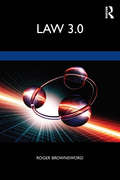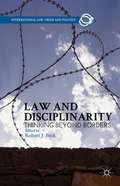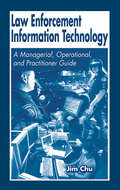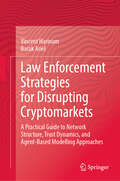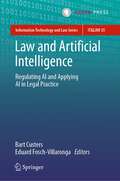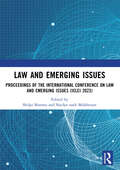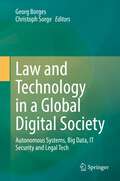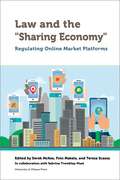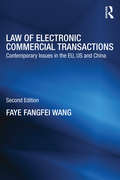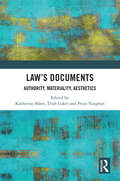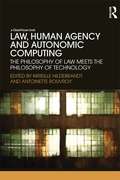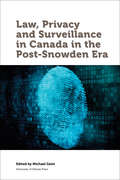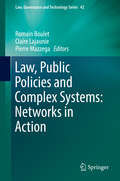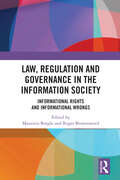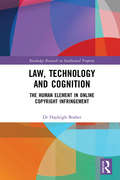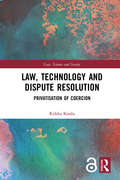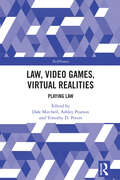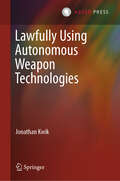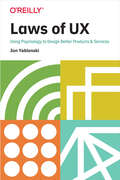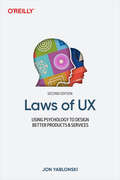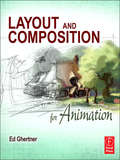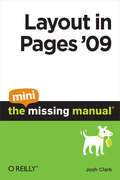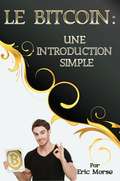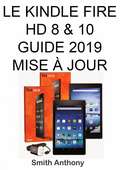- Table View
- List View
Law 3.0: Rules, Regulation, and Technology
by Roger BrownswordPutting technology front and centre in our thinking about law, this book introduces Law 3.0: the future of the legal landscape. Technology not only disrupts the traditional idea of what it is ‘to think like a lawyer,’ as per Law 1.0; it presents major challenges to regulators who are reasoning in a Law 2.0 mode. As this book demonstrates, the latest developments in technology offer regulators the possibility of employing a technical fix rather than just relying on rules – thus, we are introducing Law 3.0. Law 3.0 represents, so to speak, the state we are in and the conversation that we now need to have, and this book identifies some of the key points for discussion in that conversation. Thinking like a lawyer might continue to be associated with Law 1.0, but from 2020 onward, Law 3.0 is the conversation that we all need to join. And, as this book argues, law and the evolution of legal reasoning cannot be adequately understood unless we grasp the significance of technology in shaping both legal doctrine and our regulatory thinking. This is a book for those studying, or about to study, law – as well as others with interests in the legal, political, and social impact of technology.
Law And Disciplinarity
by Robert J. BeckIn the twenty-first century, traditional legal borders both geographic and intellectual have been increasingly contested. Many observers have questioned whether the long-held conceptions of sovereign state boundaries remain salient in a world of technology-accelerated transnational flows of people, capital, and information. Meanwhile, scholars across the social sciences and humanities have begun crossing disciplinary borders in unprecedented ways, co-opting new methodologies and engaging in meaningful and sustained dialogue about the meaning of law in its changing global context. These emerging movements prompt important questions: what are the nature and implications of shifting legal borders? What does the future hold for them? What role do new technologies play in this evolving story? Law and Disciplinarity: Thinking beyond Borders sets forth to answer these questions by way of distinguished scholars drawn from across a wide range of disciplines, including law, political science, international relations, and communications. "
Law Enforcement Information Technology: A Managerial, Operational, and Practitioner Guide
by James ChuARE YOU PREPARED FOR THE LAW ENFORCEMENT IT REVOLUTION? Law enforcement agencies that are laggards in Information Technology (IT) will soon, if not already, be considered mismanaged. Whether you are in an operational position, or you are a police officer who aspires to a higher rank, you must be aware of how IT can help you perform your job and hel
Law Enforcement Strategies for Disrupting Cryptomarkets: A Practical Guide to Network Structure, Trust Dynamics, and Agent-Based Modelling Approaches
by Barak Ariel Vincent HarinamThis book investigates the recent history of the drug market on the dark web and suggests interventions that can be used to curb the trade of illegal products in the internet's underbelly. It outlines the current landscape of this market, highlighting: • What is known about drug markets on the dark web. • How transactions involving illicit goods occur in cryptomarkets. • How the illegal trade of drugs is conducted in the dark web. • The role of blockchain technology in these transactions. The chapters that follow identify effective methods suppliers and purchasers employ to trade under conditions of uncertainty. They explore the role that trust plays in network structures and vendor selections for drug markets. The volume includes a review of the targeting strategies available for law enforcement and offers new solutions to target the trade of illicit goods on the dark web. It is ideal for law enforcement officers and practitioners combatting cybercrime.
Law and Artificial Intelligence: Regulating AI and Applying AI in Legal Practice (Information Technology and Law Series #35)
by Bart Custers Eduard Fosch-VillarongaThis book provides an in-depth overview of what is currently happening in the field of Law and Artificial Intelligence (AI). From deep fakes and disinformation to killer robots, surgical robots, and AI lawmaking, the many and varied contributors to this volume discuss how AI could and should be regulated in the areas of public law, including constitutional law, human rights law, criminal law, and tax law, as well as areas of private law, including liability law, competition law, and consumer law. Aimed at an audience without a background in technology, this book covers how AI changes these areas of law as well as legal practice itself. This scholarship should prove of value to academics in several disciplines (e.g., law, ethics, sociology, politics, and public administration) and those who may find themselves confronted with AI in the course of their work, particularly people working within the legal domain (e.g., lawyers, judges, law enforcement officers, public prosecutors, lawmakers, and policy advisors).Bart Custers is Professor of Law and Data Science at eLaw - Center for Law and Digital Technologies at Leiden University in the Netherlands.Eduard Fosch-Villaronga is Assistant Professor at eLaw - Center for Law and Digital Technologies at Leiden University in the Netherlands.
Law and Emerging Issues: Proceedings of the International Conference on Law and Emerging Issues (ICLEI 2023)
In the ever-evolving landscape of law and governance, adaptation and innovation are key to addressing the challenges of our times. This edited volume is a testament to the ever-evolving nature of the legal field and the ongoing efforts of legal scholars and academicians to dissect, analyze, and grapple with the challenges and opportunities presented by these changes. The topics covered in this book span a wide spectrum of legal domains, reflecting the complex and rapidly changing nature of our contemporary world. From corporate governance structures to emerging challenges in the digital space, from analyzing the implications of the Social Security Code 2020 in India to understanding the legal developments surrounding unorganized migrant workers during the COVID-19 pandemic, the breadth of subjects addressed here is both impressive and vital.
Law and Technology in a Global Digital Society: Autonomous Systems, Big Data, IT Security and Legal Tech
by Georg Borges Christoph SorgeThis book examines central aspects of the new technologies and the legal questions raised by them from both an international and an inter-disciplinary perspective. The technology revolution and the global networking of IT systems pose enormous challenges for the law. Current areas of discussion relate to autonomous systems, big data and issues surrounding legal tech. Ensuring data protection and IT security as well as the creation of a legal framework for the new technology as a whole can only be achieved through international and inter-disciplinary co-operation.The team of authors is made up of experienced, internationally renowned experts as well as young researchers and professionals who give valuable insights from numerous different jurisdictions. This book is written for jurists and those responsible for technology in public authorities and companies as well as practising lawyers and researchers.
Law and the "Sharing Economy": Regulating Online Market Platforms (Law, Technology, and Media)
by Derek McKee, Finn Makela, and Teresa ScassaLa controverse entoure les plateformes d’économie de partage, partiellement en raison de leur impact économique. Certains secteurs subissent des contrecoups de manière plus aigüe : les chauffeurs d’Uber font concurrence aux chauffeurs de taxi, ou les hôtes Airbnb rivalisent avec les hôtels. Par ailleurs, Uber exacerberait l’emploi précaire et mal rémunéré tandis qu’Airbnb amplifierait la spéculation immobilière et entraînerait, à terme, une hausse du coût de location.On a tenté de réglementer ce type de plateformes, mais la technologie est telle qu’elle permet aux entreprises d’aisément contourner la réglementation conventionnelle, si bien que les accusations de « concurrence déloyale » fusent de toutes parts, provoquant une remise en question du cadre réglementaire. En effet, de telles plateformes viennent brouiller les cartes, confondant les distinctions convenues entre personnel et commercial, infrastructure et contenu, autonomie contractuelle et contrôle hiérarchique. Cette ambiguïté peut avoir d’importantes répercussions sur le bon fonctionnement de l’appareil réglementaire qui encadre les principes organisateurs du travail, de la concurrence, de l’impôt, de l’assurance, de l’information et de de l’interdiction de la discrimination, sans parler de la réglementation sectorielle spécialisée.Cinq thématiques sont abordées dans cet ouvrage : les technologies de la réglementation; la réglementation de la technologie; les lieux de la réglementation (du local au mondial); la réglementation des marchés; et la réglementation du travail. Les chapitres se conjuguent pour offrir une réflexion d’une gamme d’experts sur la jurisprudence traditionnelle que sur les approches théoriques qui informent et façonnent la réglementation de l’économie du partage.Publié en anglais.
Law of Electronic Commercial Transactions: Contemporary Issues in the EU, US and China (Routledge Research in Information Technology and E-Commerce Law)
by Faye Fangfei WangThe development of new technologies places new challenges to the interpretation and implementation of legislation in the information society. The recent deployment of service-oriented computing and cloud computing for online commercial activities has urged countries to amend existing legislation and launch new regulations. With the exponential growth of international electronic commercial transactions, a consistent global standard of regulating the legal effects of electronic communications, the protection of data privacy security and the effectiveness of Internet-related dispute resolution are motivating factors to build users’ trust and confidence in conducting cross-border business and their sharing information online. The second edition of this book continues taking a ‘solutions to obstacles’ approach and analyses the main legal obstacles to the establishment of trust and confidence in undertaking business online. In comparing the legislative frameworks of e-commerce in the EU, US, China and International Organisations, the book sets out solutions to modernise and harmonise laws at the national, regional and international levels in response to current technological developments. It specifically provides information on the key legal challenges caused by the increasing popularity of service-oriented computing and cloud computing as well as the growing number of cross-border transactions and its relation to data privacy protection, Internet jurisdiction, choice of law and online dispute resolution. It considers how greater legal certainty can be achieved in cloud computing service contracts and other agreements resulted in service-oriented computing. The second edition of Law of Electronic Commercial Transactions is a clear and up to date account of a fast-moving area of study. It will be of great value to legislators, politicians, practitioners, scholars, businesses, individuals, postgraduate and undergraduate students. It provides in-depth research into finding solutions to remove eight generic legal obstacles in electronic commercial transactions and offers insights into policy making, law reforms, regulatory developments and self-protection awareness.
Law's Documents: Authority, Materiality, Aesthetics
by Katherine Biber, Trish Luker and Priya VaughanIlluminating their breadth and diversity, this book presents a comprehensive and multidisciplinary view of legal documents and their manifold forms, uses, materialities and meanings. In 1951, Suzanne Briet, a librarian at the Bibliotheque Nationale in Paris, famously said that an antelope in a zoo could be a document, thereby radically changing the way documents were analysed and understood. In the fifty years since this pronouncement, the digital age has introduced a potentially limitless range of digital and technological forms for the capture and storage of information. In their multiplicity and their ubiquity, documents pervade our everyday life. However, the material, intellectual, aesthetic and political dimensions and effects of documents remain difficult to pin down. Taking a multidisciplinary and international approach, this collection tackles the question, what is a legal document?, in order to explore the material, aesthetic and intellectual attributes of legal documentation; the political and colonial orders reflected and embedded in documents; and the legal, archival and social systems which order and utilise information. As well as scholars in law, documentary theory, history, Indigenous studies, art history and design theory and practice, this book will also appeal to those working in libraries, archives, galleries and museums, for whom the ongoing challenges of documentation in the digital age are urgent and timely questions.
Law, Human Agency and Autonomic Computing: The Philosophy of Law Meets the Philosophy of Technology
by Mireille Hildebrandt Antoinette RouvroyLaw, Human Agency and Autonomic Computing interrogates the legal implications of the notion and experience of human agency implied by the emerging paradigm of autonomic computing, and the socio-technical infrastructures it supports. The development of autonomic computing and ambient intelligence – self-governing systems – challenge traditional philosophical conceptions of human self-constitution and agency, with significant consequences for the theory and practice of constitutional self-government. Ideas of identity, subjectivity, agency, personhood, intentionality, and embodiment are all central to the functioning of modern legal systems. But once artificial entities become more autonomic, and less dependent on deliberate human intervention, criteria like agency, intentionality and self-determination, become too fragile to serve as defining criteria for human subjectivity, personality or identity, and for characterizing the processes through which individual citizens become moral and legal subjects. Are autonomic – yet artificial – systems shrinking the distance between (acting) subjects and (acted upon) objects? How ‘distinctively human’ will agency be in a world of autonomic computing? Or, alternatively, does autonomic computing merely disclose that we were never, in this sense, ‘human’ anyway? A dialogue between philosophers of technology and philosophers of law, this book addresses these questions, as it takes up the unprecedented opportunity that autonomic computing and ambient intelligence offer for a reassessment of the most basic concepts of law.
Law, Privacy and Surveillance in Canada in the Post-Snowden Era (Law, Technology and Media)
by Michael GeistYears of surveillance-related leaks from US whistleblower Edward Snowden have fuelled an international debate on privacy, spying, and Internet surveillance. Much of the focus has centered on the role of the US National Security Agency, yet there is an important Canadian side to the story. The Communications Security Establishment, the Canadian counterpart to the NSA, has played an active role in surveillance activities both at home and abroad, raising a host of challenging legal and policy questions. With contributions by leading experts in the field, Law, Privacy and Surveillance in Canada in the Post-Snowden Era is the right book at the right time: From the effectiveness of accountability and oversight programs to the legal issues raised by metadata collection to the privacy challenges surrounding new technologies, this book explores current issues torn from the headlines with a uniquely Canadian perspective.
Law, Public Policies and Complex Systems: Networks in Action (Law, Governance and Technology Series #42)
by Claire Lajaunie Romain Boulet Pierre MazzegaThis book investigates how various scientific communities – e.g. legal scientists, political scientists, sociologists, mathematicians, and computer scientists – study law and public policies, which are portrayed here as complex systems. Today, research on law and public policies is rapidly developing at the international level, relying heavily on modeling that employs innovative methods for concrete implementation. Among the subject matter discussed, law as a network of evolving and interactive norms is now a prominent sphere of study. Similarly, public policies are now a topic in their own right, as policy can no longer be examined as a linear process; rather, its study should reflect the complexity of the networks of actors, norms and resources involved, as well as the uncertainty or weak predictability of their direct or indirect impacts. The book is divided into three maain parts: complexity faced by jurists, complexity in action and public policies, and complexity and networks. The main themes examined concern codification, governance, climate change, normative networks, health, water management, use-related conflicts, legal regime conflicts, and the use of indicators.
Law, Regulation and Governance in the Information Society: Informational Rights and Informational Wrongs
by Roger Brownsword Maurizio BorghiThis edited collection seeks to map the landscape of contemporary informational interests, to evaluate a range of recognised and putative rights and wrongs associated with modern information societies, and to consider how law, regulation, and governance should be deployed in response. New technologies and new applications constantly disrupt our values, our framing of our world, and our sense of where we are and who we are. In our ‘information societies’, we entertain mixed hopes and expectations, as well as significant fears and concerns. At the root of these, there are a number of informational interests, on the basis of which certain rights are claimed and particular wrongs denounced. This book addresses these interests, considering them as relating primarily to the integrity of the informational eco-system, to the accessibility, accuracy, and authenticity of public information, and to our individual ability to control the outward and inward flows of information that relates directly to ourselves. Covering a wide range of subjects, the book’s interrogation of our contemporary information society is oriented around two questions: first, whether the information society in which we live is the kind of society that we think it should be and, second, if not, what we can reasonably expect law, regulation and governance to do in providing the basis for improving it. This book will be of considerable interest to those working at the intersection of law and technology, as well as others concerned with the legal, political, and social aspects of our information society.
Law, Technology and Cognition: The Human Element in Online Copyright Infringement (Routledge Research in Intellectual Property)
by Hayleigh BosherThis book considers a new approach to online copyright infringement. Rather than looking at the subject within a purely technological context, it provides legal analysis from a human perspective. This book highlights that there are three key instances in which the capacity of a human mind intersects with the development of copyright regulation: (1) the development of copyright statutory law; (2) the interpretation of the copyright statutory law the judiciary; and (3) human interaction with new technology. Using a novel framework for constructing digital perspectives, the author, Dr Hayleigh Bosher, analyses the laws relating to online copyright infringement. She provides insights into why the law appears as it does, shedding light on the circumstances of how it came to pass and demonstrates a clear malfunction in the interpretation and application of copyright law to online activities that derives from the disconnect between the technological and the human perspectives. The book proposes putting the human element back into copyright analysis to enable the return of reason where it has been lost, and provide a clearer, more consistent and fair legal regulation of online copyright infringement. Law, Technology and Cognition: The Human Element in Online Copyright Infringement will be of interest to students, academics, researchers, as well as practitioners.
Law, Technology and Dispute Resolution: The Privatisation of Coercion (Law, Science and Society)
by Riikka KouluThe use of new information and communication technologies both inside the courts and in private online dispute resolution services is quickly changing everyday conflict management. However, the implications of the increasingly disruptive role of technology in dispute resolution remain largely undiscussed. In this book, assistant professor of law and digitalisation Riikka Koulu examines the multifaceted phenomenon of dispute resolution technology, focusing specifically on private enforcement, which modern technology enables on an unforeseen scale. The increase in private enforcement confounds legal structures and challenges the nation-state’s monopoly on violence. And, in this respect, the author argues that the technology-driven privatisation of enforcement – from direct enforcement of e-commerce platforms to self-executing smart contracts in the blockchain – brings the ethics of law’s coercive nature out into the open. This development constitutes a new, and dangerous, grey area of conflict management, which calls for transparency and public debate on the ethical implications of dispute resolution technology.
Law, Video Games, Virtual Realities: Playing Law (TechNomos)
by Ashley Pearson Dale Mitchell Timothy D. PetersThis edited volume explores the intersection between the coded realm of the video game and the equally codified space of law through an insightful collection of critical readings. Law is the ultimate multiplayer role-playing game. Involving a process of world-creation, law presents and codifies the parameters of licit and permitted behaviour, requiring individuals to engage their roles as a legal subject – the player-avatar of law – in order to be recognised, perform legal actions, activate rights or fulfil legal duties. Although traditional forms of law (copyright, property, privacy, freedom of expression) externally regulate the permissible content, form, dissemination, rights and behaviours of game designers, publishers, and players, this collection examines how players simulate, relate, and engage with environments and experiences shaped by legality in the realm of video game space. Featuring critical readings of video games as a means of understanding law and justice, this book contributes to the developing field of cultural legal studies, but will also be of interest to other legal theorists, socio-legal scholars, and games theorists.
Lawfully Using Autonomous Weapon Technologies
by Jonathan KwikThis monograph provides a practical and operational perspective to the question of how to lawfully employ autonomous weapon systems (AWS) from the point-of-view of the technology's end-users: field commanders. While there is international consensus that targeting rules such as proportionality and precautions must be respected when using AWS, there is legal and practical ambiguity as to how to translate this normative commitment into practice. How are commanders in the field, when guns are already blazing, expected to exercise command-and-control when ordering AWS-attacks, and ensure that their targeting obligations remain fulfilled? The book discusses how commanders can use existing targeting frameworks to ensure that their use of AWS remains in compliance with the rules governing the conduct of hostilities. It invites the reader to step into the shoes of the military commander with all the operational pressure and uncertainty inherent to this position, and explores amongst others: - How to maintain control of AWS throughout a targeting cycle; - How to make informed and reasoned deployment decisions by analysing information related to the technical parameters of the AWS, the characteristics of the operational environment, and enemy countermeasures; - Under which circumstances AWS may not be used under targeting rules, such as indiscriminate attack, proportionality and the duty to cancel/suspend; - What extra precautionary measures unique to AWS technology can and should be employed; - When it is militarily desirable to employ AWS over other alternatives; and - Under what circumstances criminal liability may be attributed for AWS-related harm. It offers both academic and practical outputs: new legal and doctrinal insights on the technology that is useful for future legal developments, and workable recommendations and efficient flowcharts that can be adopted by commanders, military organisations or policymakers to ensure IHL-compliant deployment of AWS. Dr. Jonathan Kwik is a researcher at the T.M.C. Asser Institute in The Hague specialised in artificial intelligence and targeting law, and is a member of the Board of Experts of the Asia-Pacific Journal of International Humanitarian Law.
Laws of UX: Using Psychology to Design Better Products & Services
by Jon YablonskiAn understanding of psychology—specifically the psychology behind how users behave and interact with digital interfaces—is perhaps the single most valuable nondesign skill a designer can have. The most elegant design can fail if it forces users to conform to the design rather than working within the “blueprint” of how humans perceive and process the world around them. This practical guide explains how you can apply key principles in psychology to build products and experiences that are more intuitive and human-centered. Author Jon Yablonski deconstructs familiar apps and experiences to provide clear examples of how UX designers can build experiences that adapt to how users perceive and process digital interfaces.You’ll learn:How aesthetically pleasing design creates positive responsesThe principles from psychology most useful for designersHow these psychology principles relate to UX heuristicsPredictive models including Fitts’s law, Jakob’s law, and Hick’s lawEthical implications of using psychology in designA framework for applying these principles
Laws of UX: Using Psychology to Design Better Products & Services
by Jon YablonskiAn understanding of psychology-specifically the psychology behind how users behave and interact with digital interfaces-is perhaps the single most valuable nondesign skill a designer can have. The most elegant design can fail if it forces users to conform to the design instead of working within the "blueprint" of how humans perceive and process the world around them.This practical guide explains how you can apply key principles of psychology to build products and experiences that are more human-centered and intuitive. Author Jon Yablonski deconstructs familiar apps and experiences to provide clear examples of how UX designers can build interfaces that adapt to how users perceive and process digital interfaces.You'll learn:How aesthetically pleasing design creates positive responsesThe principles of psychology most useful for designersHow these psychology principles relate to UX heuristicsPredictive models including Fitts's law, Jakob's law, and Hick's lawEthical implications of using psychology in designA practical framework for applying principles of psychology in your design processThis updated edition includes an even deeper connection to the underlying psychological concepts that govern the principles explored in the book, along with accompanying UX methods and techniques. Examples have been updated to ensure the deconstructed apps and experiences remain familiar and relevant.
Layout and Composition for Animation
by Ed GhertnerThis essential, hands-on guide is filled with examples of what a composition should look like and example of poorly designed layouts. Spot potential problems before they cost time and money, and adapt creative solutions for your own projects with this invaluable resource for beginner and intermediate artists. With Beauty and the Beast examples and Simpson character layouts, readers will learn how to develop character layout and background layout as well as strengthen composition styles with a creative toolset of trick shot examples and inspirational case studies. A companion website will include further technique based tools, finalized layout and composition examples and tutorials for further artistic skill development.
Layout in Pages '09: The Mini Missing Manual
by Josh ClarkPages '09 is more than just a word processor. It lets you create gorgeous page layouts for glossy newsletters, catalogs, brochures, greeting cards-you name it. This eBook makes you an instant expert in Pages' layout features. You'll learn how to arrange your text so it really flows and how to complement it with images, sounds, and movies.
Le Bitcoin : Une Introduction Simple
by Eric Morse Avinash MayaramComprendre les Bases du Bitcoin Le Bitcoin est une monnaie numérique révolutionnaire qui transforme l’argent tel que nous le connaissons, mais il peut être difficile à comprendre pour l’utilisateur moyen. Plus maintenant ! Ce livre élimine la complexité et enseigne les bases du Bitcoin dans un langage simple et facile à comprendre. Ce n’est pas un manuel. C’est un livre élémentaire non technique qui répond aux questions les plus courantes et importantes que posent les utilisateurs à propos du Bitcoin. Pas de jargon. Pas de bla-bla technologique. Aucune connaissance technique préalable n’est requise. Dans ce livre, vous trouverez les réponses à ces questions : Le Bitcoin, c’est quoi ? Qu’est-ce qui le rend spécial ? La Blockchain, c’est quoi ? Le minage, c’est quoi ? Qui contrôle le Bitcoin ? Le Bitcoin est-il sécurisé ? Le Bitcoin est-il anonyme ? Comment puis-je utiliser le Bitcoin de manière plus sûre ? Devrais-je investir en Bitcoin ? ...Et Bien Plus ! Et Vous n’aurez pas le sentiment d’apprendre une nouvelle langue ou d’obtenir une licence en informatique ! Prérequis : AUCUN ! Si vous avez déjà effectué un achat en ligne, vous avez déjà ce qu’il faut pour comprendre ce livre et apprendre les bases du Bitcoin.
Le Guide complet pour débrider le Stick Fire TV
by Rob StiegelmanComment installer Kodi sur les appareils Fire TV et Stick Fire d'Amazon Suite à l’installation de Kodi sur les appareils Fire TV, vous aurez accès à tout le contenu que vous voulez, comme des émissions de télévision, de la musique et des films. Voici ce que vous obtiendrez : Tout sur Kodi sur Stick Fire Installation de Kodi et débridage des appareils Stick Fire TV - Fonctionne sur tous les appareils Résolution des problèmes Profitez de l’accès à des films, de la musique, des émissions de télévision, des applications et plus encore ! --> Faites défiler jusqu’en haut de la page et cliquez sur Ajouter au panier pour acheter instantanément Avertissement : Cet auteur et / ou le(s) titulaire(s) des droits ne font aucune réclamation, promesse ou garantie sur l’exactitude, l’exhaustivité ou l’adéquation du contenu de ce livre, et décline expressément toute responsabilité pour les erreurs et les omissions dans le contenu. Ce produit est destiné à un usage de référence uniquement.
Le Kindle Fire HD 8 & 10 Guide 2019 Mise À Jour: Moyens faciles et rapides pour comprendre votre Kindle Fire HD et solution aux problèmes courants
by Smith AnthonyTHE KINDLE FIRE HD 8 & 10 GUIDE 2019 MISE À JOUR Les guides de ce manuel sont principalement destinés aux utilisateurs de KINDLE Fire qui n'ont rien appris de nouveau sur la façon de maximiser votre Kindle Fire HD 8 et 10. Vous obtiendrez de nouveaux trucs et astuces cachés qui vous permettront de maîtriser votre appareil. Ce manuel vous guidera pas à pas vers les fonctions avancées des processus Kindle Fire HD 8 et 10 sur la configuration initiale, les fonctions de base, les paramètres avancés et bien plus encore. D'autres informations importantes que vous obtiendrez de ce livre incluent ; Raison du Kindle Fire HD 8 et 10 Comment mettre en place Kindle feu HD 8 et 10 La meilleure façon de charger votre Kindle Fire HD 8 et 10 À L'AIDE D'UN ORDINATEUR À L'AIDE D'UN ADAPTATEUR MURAL Navigation sur l'écran de votre terminal Magasiner sur Amazon Fonctionnalité des trois boutons de l'écran de votre appareil Magasiner sur Amazon COMMENT FAIRE UN MIROIR DE VOTRE FEU ALLUMÉ HD À VOTRE TÉLÉVISEUR À L'AIDE D'UN BÂTON DE FEU Comment accélérer votre feu lent HD Mon feu allumé ne s'allume pas. Votre feu allumé HD ne se charge pas Mon feu allumé n'a pas de son Comment maximiser Alexa sur un feu HD Comprimé Possibilité de pouvoir changer la couleur du clavier Possibilité de changer le texte à la voix de la parole Arrêt automatique pour le Wi-Fi Possibilité d'avoir des émojis ou des émoticônes sur le clavier Possibilité de changer le comportement d'autocorrection Comment retrouver votre tablette perdue à l'aide du GPS Fonds d'écran Capacité de refléter votre feu de Kindle Ne tergiversez pas davantage, naviguez vers le haut et cliquez sur le bouton "ACHETER" pour obtenir ce manuel afin de maîtriser votre appareil et devenir un expert en K
